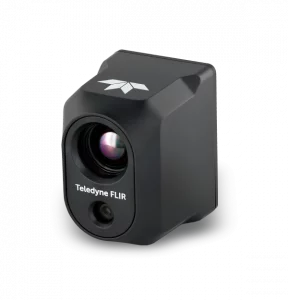
Continue reading, or listen below:
The Hadron™ 640R is a major upgrade from the original Hadron, still an major innovation for the industry. “The original Hadron had a 320 x 240 pixel non-radiometric thermal camera paired with a 12MP visible camera, and was designed to pair with the NVIDIA Jetson TX2 Microprocessor,” Brodbeck explains. “This industry moves so fast that today, this is old news.”
The new Teledyne FLIR Hadron 640R pairs a 640×512 resolution radiometric Boson® thermal camera with a 64MP visible camera in a small, 56 gram form factor; and offers MIPI output. Demonstrated in the Teledyne FLIR booth, the output – both thermal and visible – is remarkably clear: and combined with the radiometric capability, means more precise data available for end users.
For drone manufacturers, the Hadron 640 R is an accelerator to getting a highly sophisticated sensor integrated with their platforms. “The Hadron 640 R is an integration module,” says Brodbeck. “On the hardware side, we’re speeding everyone’s process up by providing all the pieces you need – the sensor and the lens, aligned, on the circuit boards – so people can utilize this within a matter of months.” Teledyne FLIR has developed the Hadron 640R for new processors powerful enough to handle the data: NVIDIA Jetson Nano, Qualcomm Snapdragon 865, and, in process, the Qualcomm Snapdragon RB5.
“We’re seeing a huge improvement in performance. We now see people using very different processors, and we want to help speed up their integration,” he says. “We’re developing drivers and reference software to help designers, because everyone wants this up in the air as fast as possible.”
The demand for the new unit is huge – but that, says Ezra Miller, Senior Director of Marketing, is no problem. “We’re excited for the demand. One of our strengths is in our control of the supply chain, so we’re able to deliver.”
The Hadron 640R adds radiometry to the offering, critical for many industrial applications. “On the thermal side, having the radiometry gives so much more information, especially for inspections,” Brodbeck explains. “When you are flying over solar farms, you might see a lot of glowing cells – but you need more information to see if there is really a problem. Our isotherm features allow you to pick out those truly problematic cells to create a work order.”
The better and more powerful camera gives better and more powerful data. “People just want more resolution, and in a small form factor.” says Brodbeck. “If you start out with a lot of resolution, you still have a lot of pixels on target when you zoom in.”
For many applications, that high resolution is a game changer. In public safety applications, “Drones are often about looking for people, and being able to figure out who they are based on what they’re holding and what they’re doing,” Brodbeck comments. “More resolution simply means better decisions, better situational awareness. The consequences of getting it wrong are high – more resolution helps you get it right.”
Read more about Teledyne FLIR:
- Teledyne FLIR on Counter Drone Solutions: The Big Problem with Small Drones
- Mapping with Thermal Drones: Teledyne FLIR Talks Best Practices
- Teledyne FLIRs Thermal Zoom Drone Payload: More Pixels. More Accuracy.
- Thermal Zoom Drone Payload: Introducing Teledyne FLIR VUE TZ20-R
Miriam McNabb is the Editor-in-Chief of DRONELIFE and CEO of JobForDrones, a professional drone services marketplace, and a fascinated observer of the emerging drone industry and the regulatory environment for drones. Miriam has penned over 3,000 articles focused on the commercial drone space and is an international speaker and recognized figure in the industry. Miriam has a degree from the University of Chicago and over 20 years of experience in high tech sales and marketing for new technologies.
For drone industry consulting or writing, Email Miriam.
TWITTER:@spaldingbarker
Subscribe to DroneLife here.